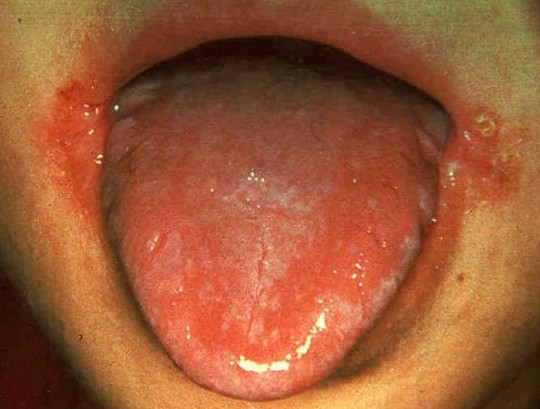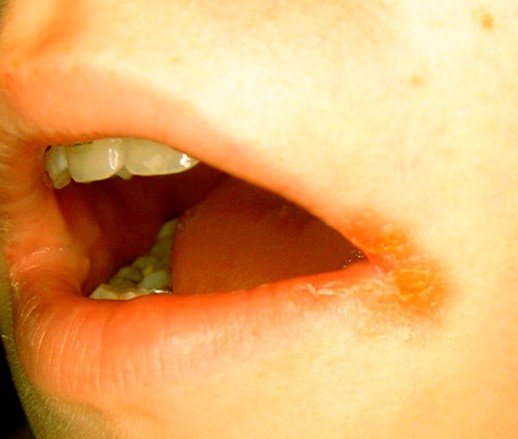Angular Cheilitis
Last reviewed by Dr. Raj MD on January 12th, 2022.
What is Angular cheilitis?
This is a medical condition that affects the corner of your mouth. It is not a medical term that you would not hear very often as when most people have this medical condition they just call it “cracks in the corner of their mouth.” It is also known as cheilosis or perleche. It refers to chapping or drying out in the corners of the mouth. It is considered a chronic inflammatory condition. It is a medical condition that can last from several days to even months. How long it lasts depends on whether you seek treatment for the condition or not. It can affect people of all ages, gender, or race.
Angular Cheilitis Symptoms
If you have angular cheilitis some of the symptoms that you might notice may include:
- Ulceration
- Tissue tenderness and softness
- Drainage of pus
- Fissuring and cracking in the corners of your mouth with redness
- Sores or cuts in the sides or corner of your lips that can look like a red rash
- It can be painful as lesions develop, which are usually due to the movement of your mouth and where the cracks are located
- Bleeding
- Crust-like scabs
- The cracks can split vertically or long ways in line with the opening of your mouth
- Chapped lips
- Inflammation of your lips
- Possible swelling that can spread around your mouth
Angular Cheilitis Causes
When a person has angular cheilitis it usually associated with a bacterial infection, (Staphylococcal) or fungal infection (Candida). It may also be associated with thrush (oral candidiasis). There are also other situations and conditions that could cause a person to develop angular cheilitis which can include:
- The corners of your mouth drop because of dentures that do not support the facial musculature adequately
- Chronic pooling of saliva which can encourage bacterial and fungal growth
- Having diabetes mellitus
- Having undergone neck and head radiation
- Being immunocompromised
- Poor diet and inadequate water intake which includes having a deficiency of iron, vitamin B2, and zinc
- Harsh weather when your lips can start to lose their moisture and become dry, especially during the summer and winter
- Oral herpes
- Skin irritants such as toothpaste with the ingredient sodium lauryl sulfate
- Breathing through your mouth especially when sleeping at night because the continuous flow of air in and out of your mouth can make your lips excessively chapped and dry
- Bad habits such as frequently licking your lips which can lead to the buildup of moisture at the corner of your mouth making these areas infection breeding sites. Another bad habit is biting the corners of your lips a lot causing them to crack
- Dentures that are not cleaned everyday can comprise your oral health and could lead to infection
- Being malnourished
- Having anorexia or bulimia
- Allergic reactions to makeup or lip balm
- Anemia
Angular Cheilitis Pictures
Collection of pictures of Angular Cheilitis…
Angular Cheilitis Treatment
Before you can treat angular cheilitis you need to find out what is causing this medical condition so you can use the right treatment. Many times you can treat it with home remedies but if they do not work you should seek medical attention to rule out any underlying serious medical conditions or to seek a stronger form of treatment. Many times it will clear up on its own.
Some of the treatments that you can try at home can include:
- Drink plenty of water each day
- Keeping the area dry by using a straw to drink
- Follow a healthy diet and avoid eating sugary items, drinking caffeinated beverages, and spicy foods. Make sure that your diet is rich in green leafy vegetables like spinach along with carrots, legumes, tomatoes
- Apply petroleum jelly to the cracks before you go to bed to help soothe the chapped corners of your mouth
- Using aloe Vera to help reduce the pain that can be associated with angular cheilitis. You can use fresh aloe Vera pulp or gel several times a day
- Using margosa leaves powder. Apply the powder to the area that is affected and within a few days you will see results
- Using extra virgin olive oil to soothe the cracks, soften your lips, and prevent your lips from drying out
- Apply cucumber juice to the cracked areas to help heal the condition and soothe the pain. To do this gently run a slice of fresh cucumber on the corners of your split lip
- Applying honey to the areas. If you have chronic angular cheilitis it could indicate a bacterial infection. Honey displays antibacterial properties and is a natural remedy to make your lips supple and soft along with getting rid of the cracks
- Applying pure vitamin E oil acts as a good moisturizer and will help to get rid of the cracks. You should apply it several times a day to help eliminate the dryness of your lips
- Use unflavored lipsticks
- Take a vitamin B complex everyday if the cause is vitamin B deficiency
- Taking an iron or zinc supplement if the cause is a deficiency in either of these minerals
- Improving your dental hygiene especially if you wear dentures
If your physician determines that your case of angular cheilitis is caused by a vitamin B deficiency they may replace it by using injections of vitamin B. They may also have you use over-the-counter topical creams or ointments or give you a prescription for ones that have an antibiotic in them. If the cause is a fungal infection it can be treated with a prescription or over-the-counter anti-fungal cream. If the cause is oral herpes or herpes simplex virus your physician may prescribe a topical antiviral medication. You may also need to see a dentist if the cause is ill fitting dentures.
Is angular cheilitis contagious?
No, angular cheilitis is not contagious.



